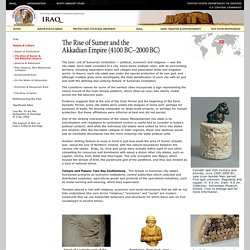

Cuneiform Writing @ University of Pennsylvania Museum of Archaeology and Anthropology. Early Sumerian Tablet The Early Sumerian Tablet represents the second stage in the development of the Mesopotamian system of recording ancient economic activities.

The very first stage of bookkeeping was tied to specific economic items represented by tokens, originally made from stone and then from clay. There was a specific token for sheep, another for wine, another for a day's work, etc. To record 3 sheep and 2 jugs of wine, the ancient bookkeeper would create the token for sheep three times and the token for wine twice. These tokens were then stored in a container, probably made of cloth or leather. Around 3000 BC the second stage of recording economic activities began to develop. The Sumerians lived along the lower Tigris and Euphrates valley in what is now Iraq. Mesopotamia - The British Museum. Sumer. Sumer was the southernmost region of ancient Mesopotamia (modern-day Iraq and Kuwait) which is generally considered the cradle of civilization.

A brief introduction to the Sumerians. The original "Stairway to Heaven".

Sumerian Culture. Before the Sumerians appeared on the land, it had been occupied by a non-Semitic people, referred to as Ubaidians.

Their name comes from the village of Al Ubaid, in which their remains were first found by archaeologists. The Ubaidians settled the region between 4500 and 4000 BC. They drained the marshes and introduced agriculture. They also developed trade based on small handicraft industries such as metalwork, leather goods, and pottery. The World's First Cities In ancient Mesopotamia, a land of blazing sun and very little rainfall, irrigation was vital for farming. The rich soil produced abundant crops of barley, emmer (a kind of wheat), beans, olives, grapes, and flax. The Sumerians built their villages on artificial mounds to protect them from floods. Each Sumerian city rose up around the shrine of a local god. Horses and camels were still unknown, but sheep, goats, oxen, donkeys, and dogs had been domesticated. The Sumerians: a HistoryWiz Exhibit.
The Rise of Sumer and the Akkadian Empire. The basic unit of Sumerian civilization — political, economic and religious — was the city-state.

Each state consisted of a city, some times multiple cities, with its surrounding territory, including dependent towns and villages and associated fields and irrigation works. Akkad and the Akkadians of Mesopotamia (Ancient Akkad) A history of ancient Akkad (Akkadians) from its rise to fall including its kings, cities, laws and contributions to civilization Main Akkadian Page Sargon The Great The Legend of Sargon Sargon and other Kings Reign Advice from father to son Akkad and the Arts Care to express an opinion on a current or past historical event?

Need to ask a question from our many visitors? Just visit our Forum and leave your message. Forum Weekly Poll The Akkadians were a Semitic people living on the Arabic peninsula during the great flourishing period of the Sumerian city-states. But Sargon's ambitious empire lasted for only a blink of an eye in the long time spans with which we measure Mesopotamian history. History of Ancient Mesopotamia - TimeMaps. Assyrian Civilization - TimeMaps. Assyria, 1365–609 B.C. Babylon. After the fall of the last Sumerian dynasty, the center of Mesopotamian power shifted from Sumer to Babylonia, which consisted of both Sumer and Akkad peoples and encompassed the region from the northern edge of the Persian Gulf to present-day Baghdad.

Its name derives from the city of Babylon, which would dominate Mesopotamia, both politically and psychologically, for more than 2,000 years. Kings of Isin and Larsa. Ishbi Erra, a governor of Isin under the last Ur III ruler, exploited the weakness of the central state to set himself up as king, and established a dynasty that lasted for about a century. After expelling the Elamites, Ishbi Erra gained control of the Sumerian cities of the south as well as central Babylonia. The Isin kings followed the Ur III model and were the last Mesopotamian kings ever to assume divine status. Much earlier texts describe people identified as Amorites living and working in Babylonia, part of the diverse mixture of peoples that had been settling there. The Babylonian Empire - TimeMaps.